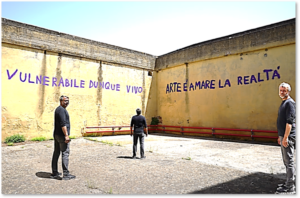
‘Alchemical Officina of Ideas’: Ideas, from vision to reality, are worked on, shaped, and transformed into creative devices.
The Artist Residencies provide artists and creative professionals with the time, space, and resources to work, individually or collectively, on aspects of their artistic practice that require deeper exploration.
The Residency serves as a hub for the dissemination of knowledge and culture, closely connected to the community and cultural heritage of the region.
‘Alchemical Officina of Ideas’ is an annual Artist Residency with special features:
- Curated by artists.
- Research-based: Artists use research processes to create the residency experience, forming a unique relationship between artists, people, and the location where the residency takes place.
- Thematic: Artists are asked to contribute to a common theme to draw attention to the subject and facilitate a process of regeneration.
- Production-based: These residencies focus on the creation of an artistic project. The VulnerarTe Movement provides materials, expertise, and an infrastructure network in a specific artistic field to support the production of artistic work (the process is an integral part of the final work).
- Transdisciplinary and cross-sectoral: These residencies host artists working in various artistic disciplines and increasingly offer opportunities for collaboration with partners from different sectors beyond the artistic world.
- Hosted in the Contemporary Cathedrals of Vulnerability. In Italy alone, there are currently seven million abandoned buildings, as highlighted by the latest ISTAT census.
The first Artist Residency of the VulnerarTe Movement took place in Velletri, from April 30th to September 30th, 2023, at the former Pontifical Prison.
It was conceived by a group of artists and professionals in film, dance, music, and photography, along with teachers from Roman high schools and painting-sculpture technical students from the Academy of Fine Arts in Rome. The idea was to experiment with the observational experiences and insights from Sergio Mario Illuminato’s BOOK ‘Corpus-et-Vulnus‘ in a unique and unrepeatable artistic residency at the former Pontifical Prison in Velletri. This was done before the irreversible transformation of this historical and cultural heritage into a new architectural structure serving the community.
These spaces date back to the mid-19th century and have been included in the last ISTAT Census of over seven million unused buildings in Italy. The Lazio Region, the Metropolitan City of Rome Capital and the City of Velletri recognized the importance of these Artist Residency and granted their sponsorship and special use of the facility, which was transformed into a place for reflection and dialogue for future generations.
Over the six months of the Residency, this space in a state of hibernation was explored to create and realize a deep, articulate, critical, fragile, and necessary “intellectual space.” Through unconventional perspectives guided by the concept of transdisciplinarity, a relational and inclusive life was practiced, allowing for the exploration and revelation of the nature of the multiple connections between isolated issues, where questions were revisited, alternatives reconsidered, and interrelationships revealed (UNESCO – Division of Philosophy and Ethics, 1998).
This specific research has focused on unconventional perspectives guided by the concept of transdisciplinarity, aiming to understand the complexity of the present world. We have ventured into the unusual space of interstitial zones between painting∞sculpture, influenced by the language of cinema, dance, music, and photography, in order to continually re-signify exhibition spaces and experiment with creative relational practices that reveal connections, affinities, and possible developments with the participating elements.
This has been the exciting necessity in the ongoing expressive research of an authorial dimension that, through the ‘COSMIC-WEAVE-FABRIC‘ of ‘COMMUNICATING-ARTISTIC-ORGANISMS,’ is based on ‘CO-EXISTENCE‘ in creating irregular performative rings conceived as places of encounter and community, spaces for generation and active knowledge, not just for consumption.
It represents a reversal of the trend in art, moving away from exclusive and exhausted castes and self-referential systems that have run out of breath. From here, the primordial themes of ‘BODY-BEYOND-MATTER,’ ‘VULNERABILITY,‘ ‘NOMADIC ETHICS,’ and ‘CONVERGENCE-AESTHETICS‘ based on the creative mechanisms of Ruins have intertwined to expand and divert contemporary inquiries regarding what is propagated through the para-verse. In this context, the neologism refers to the incessant degradation of virtual worlds towards the superficiality of the mirror-worlds of our everyday life.
The end result was the birth of the ‘VulnerarTe‘ MOVEMENT, the TRANSDISCIPLINARY PERFORMATIVE PRACTICE ‘iosonovulnerabile,’ and the creation of the SHORT FILM ‘Vulnerare.’ These intertwined activities encapsulate the essence of an immersive site-coexistence project that continues to evolve.
The facility that hosted the Residency was owned by the State for many years. Several proposals were put forth for its conversion to different purposes. We don’t know many details about its bureaucratic history, but the question of how to requalify it has troubled the last three municipal administrations, all eager to repurpose the building for practical use. Thanks to an expenditure of 1.3 million euros, the former prison was preserved from any real estate speculation and is now owned by the Municipality of Velletri.
In one of the many accidental synchronicities that mark our journey, the project presented on these pages represents the final experience and living testimony of the building in the state it was in when we encountered it, preserving the memory and original traces of its two-century history. The Book, the Artist Residency, the Transdisciplinary Performative Practice, the Short film, and the photographic snapshots of the entire Residency process, along with the testimonies of the participants, constitute the last useful documentation before the architectural renovation and change of purpose and use of the 19th-century structure, scheduled for the coming months.
